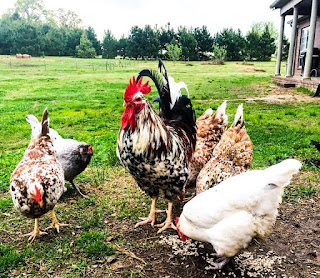Last fall, I set up a breeder pen with this guy:
 |
| My best rooster bred to date. (Needs yellow legs.) |
Not only was he the most white rooster of last year's hatch - he was also the largest. Quite a turn around, as previously I could get color or size, but never both on the same rooster!
After last year's fiasco where my top rooster of 2015 / 2016 - a gorgeous Buff Sussex / Speckled Sussex mix - ended up infertile - I was really afraid of a repeat this year! I penned this guy with hens in September, waited 30 days through October (it takes 30 days to guarantee the DNA is set) and put eggs in the incubator for a November hatch.
 |
| September breeding pen. |
Thankfully, it was successful, and I'm happy to be raising about 18 of his chicks right now!
It wasn't without hiccup unfortunately. Our heat was so brutal on the hens last year, they started to lay a bit in late October and into November, only to shut down due to lack of light. Chickens naturally stop laying for the winter, based on the amount of daylight, despite the fact our temps were balmy and mild. It wasn't their fault. Temps stayed well into the 100's into October and everyone in the Valley was reporting the same issues in December -
no eggs.
For my 10 or so hens in there I was getting maybe 2 or 3 eggs per day. Some days, only one?
The rooster also lost interest in the hens around this same time, and eggs started turning up "blank" again, so I pulled many of the hens out and scaled the pen back down again. Fertility on the next batch improved. However in the meantime, dozens of eggs from my very best hens were tossed in the garbage - infertile.
Meanwhile, in the pen next door, it appeared my best rooster from the previous year had not recovered at all, and nearly every egg in his pen was a dud!
Between the two pens, I set 100+ more eggs in these months, but only about 40 hatched live chicks.
So there are issues - but I
do have some chicks and we are back on track again!
I now have the pens sorted out and I have ambitiously put my favorite boy back in with a ton of hens, probably way too many, and will likely have to scale back again? But now that the last batch tested nearly perfect fertility, I'm willing to give him a chance!
Right now I wanted to document this breeder pen, because it will be helpful later when I am growing out the chicks. Often I will be able to tell who the Mom is based on certain features. So here is who I put in the pen as of mid February which means any DNA in the hens will be his 100% by mid March. (I am still keeping the hen's eggs to hatch as all will be nice chicks due to the mother.)
 |
| Mille Hens - of various sizes and shapes. |
Enjoy pictures of the lovely hens!
 |
Terrible top line. Can it be fixed in the offsping?
Great color.. Legs were yellow, now fading. |
 |
Hen in front: Best Color
Behind her: Bold spots, good size
Last: Best size, needs spotting. |
 |
| Mille hen, medium size, vivid color. |
 |
| Dun Mille - from Light Sussex bloodlines. |
 |
| Light Sussex / Aloha mix - good size, needs more spots. |
 |
| Needs yellow legs. Great size , bold spots. |
 |
| Huge size - Buff Sussex / Speckled Sussex cross. |
 |
| Best hen bred to date. Needs yellow legs. BIG. |
 |
| Best hen bred to date. Last year's stock. |
 |
| Very pale cream background with vivid black marks. |
 |
| GREAT color. Needs size. Otherwise fantastic. |
I saw the rooster cover 3 hens while I was out taking pictures, though unfortunately I did not see him cover my two favorite girls. So I may need to pull those girls out and pen him with just two.
Interestingly, a roo's DNA from just a single "encounter" may fertilize eggs for the next two weeks of a hen's laying cycle! It was good to note that the longer days have kick started not just the laying of the hens, but the behavior of the rooster as well. Both genders are affected by the increasing daylight.
Next post will cover some of this boy's babies, chicks which are now about 3 months old.
I set up a new pen, to replace the older rooster that was under- performing, and I'll share pictures and goals there later. Hopefully I will have two functional breeder pens by the end of March? I want to hatch as many chicks as I can before the heat turns up in May!







































































